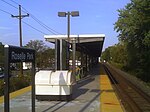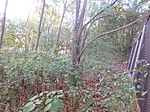Roselle Park station
1891 establishments in New JerseyFormer Central Railroad of New Jersey stationsFormer Lehigh Valley Railroad stationsNJ Transit Rail Operations stationsRailway stations in Union County, New Jersey ... and 3 more
Railway stations opened in 1891Stations on the Raritan Valley LineUse mdy dates from May 2023

Roselle Park is a New Jersey Transit railroad station in Roselle Park, New Jersey. Located on the Conrail Lehigh Line which is owned by Conrail Shared Assets Operations on West Lincoln Avenue between Chestnut Street and Locust Street, it is served by Raritan Valley Line trains that travel between Newark Penn Station and Raritan. There is also limited service between High Bridge and New York Penn Station and one weekday morning train to Hoboken Terminal.
Excerpt from the Wikipedia article Roselle Park station (License: CC BY-SA 3.0, Authors, Images).Roselle Park station
Lincoln Avenue West,
Geographical coordinates (GPS) Address Nearby Places Show on map
Geographical coordinates (GPS)
| Latitude | Longitude |
|---|---|
| N 40.6672 ° | E -74.2666 ° |
Address
Lincoln Avenue West
07204
New Jersey, United States
Open on Google Maps






